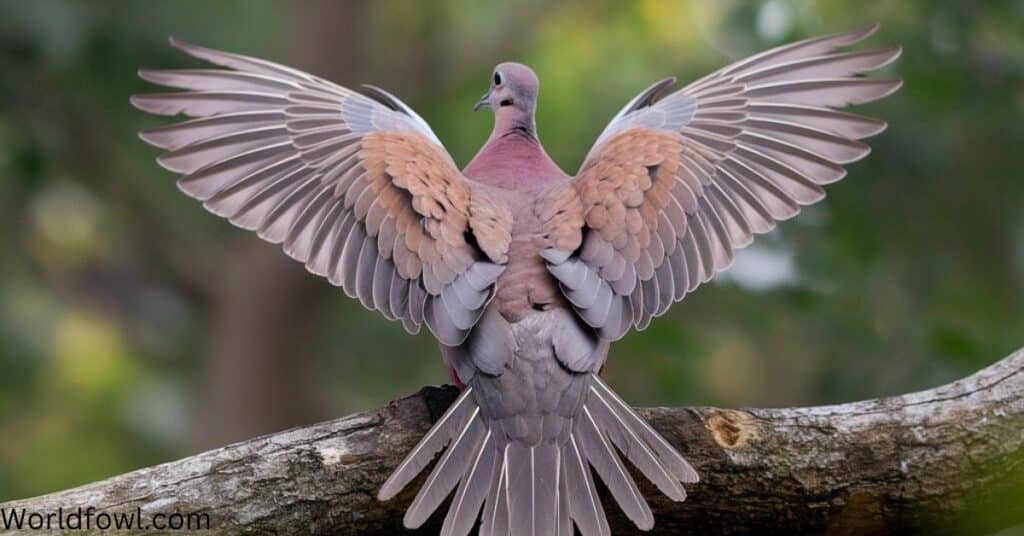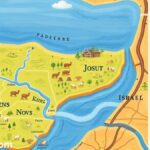Have you noticed the absence of that familiar, gentle cooing that once filled your mornings? You’re not alone. Many nature enthusiasts and casual observers alike have been asking, “Why don’t I hear mourning doves anymore?”
This comprehensive guide will delve into the reasons behind this perceived silence, explore common misconceptions, and provide insights into the fascinating world of these beloved birds.
Understanding Mourning Dove Behavior
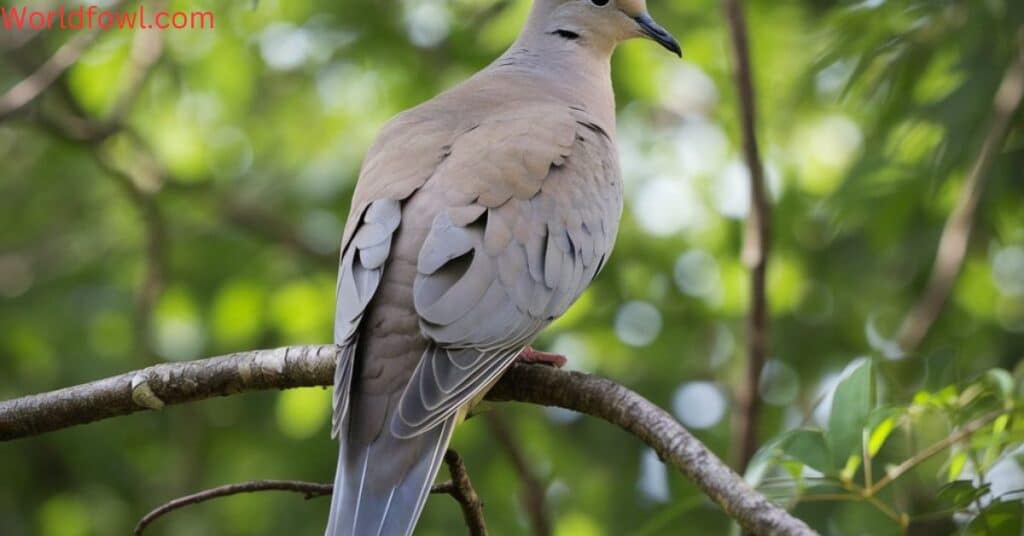
Mourning Doves, with their soft, mournful calls, have long been a staple of North American soundscapes. These gentle creatures, known for their graceful flight and soothing coos, play a crucial role in our ecosystems. But to understand why you might not be hearing Mourning Doves as often, we first need to explore their behavior.
Seasonal Patterns and Migration Habits
Mourning doves are partially migratory, meaning some populations move south for the winter while others remain in their breeding grounds year-round. This variation in behavior can significantly impact when and where you hear their calls.
- Spring and Summer: Peak calling season, as males attract mates and establish territories
- Fall: Decreased vocalization as birds prepare for migration or winter
- Winter: Reduced calling in colder regions, but may increase in warmer areas where doves overwinter
Breeding Cycles and Vocalization
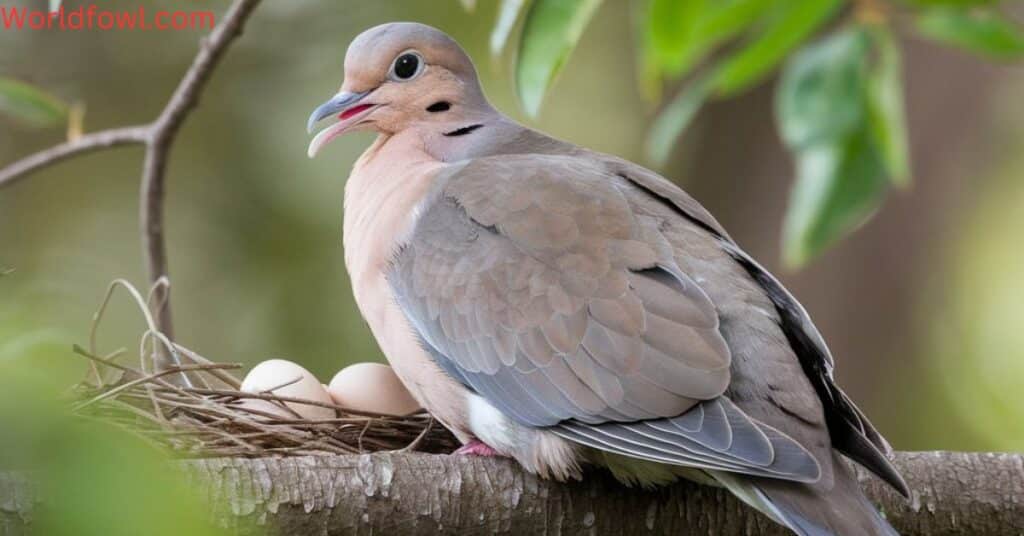
The mourning dove’s breeding season typically runs from spring through early fall. During this time, males become particularly vocal, using their distinctive coos to attract mates and defend territories.
Key Breeding Behaviors:
Nest building (usually in trees or shrubs)
- Egg-laying (typically 2 eggs per clutch)
- Incubation (14-15 days)
- Caring for young (nestlings fledge after 12-14 days)
As the breeding season progresses, you may notice a decrease in calling as pairs focus on raising their young.
Daily Routines: When Are Doves Most Vocal?
Mourning doves are creatures of habit, with fairly predictable daily routines:
| Time of Day | Activity |
| Dawn | Most vocal, calling to establish territory |
| Mid-morning | Foraging for food |
| Midday | Resting or preening |
| Late afternoon | Second peak in vocalization |
| Dusk | Settling in for the night |
Understanding these patterns can help you pinpoint the best times to listen for mourning dove calls.
Environmental Factors Affecting Mourning Dove Populations
While mourning doves are not facing extinction, various environmental factors can impact their populations and, consequently, how often we hear them.
Habitat Loss and Urbanization
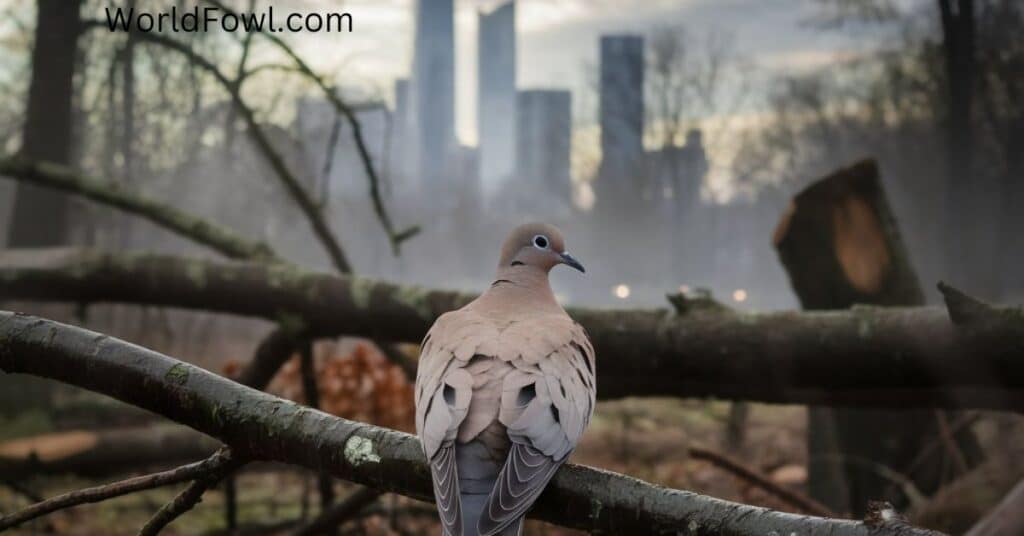
As human development expands, natural habitats shrink. This urban sprawl can have significant effects on mourning dove populations:
- Loss of nesting sites: Fewer trees and shrubs mean fewer places for doves to build nests
- Reduced food sources: Development can eliminate native plants that provide seeds, a staple of the mourning dove diet
- Increased dangers: More buildings and vehicles lead to higher collision risks
“The single biggest threat to bird populations is habitat loss and degradation.” – National Audubon Society
Climate Change and Its Effects on Dove Distribution
Climate change is altering ecosystems worldwide, and mourning doves are not immune to its effects:
- Shifting breeding ranges northward
- Changes in migration patterns
- Alterations in food availability and timing
These changes can affect where and when we hear mourning doves, potentially explaining their apparent absence in some areas.
Changes in Food Availability and Predator Dynamics
Mourning doves primarily feed on seeds, making them susceptible to changes in plant communities. Additionally, shifts in predator populations can impact dove numbers:
- Increased raptor populations in some areas may lead to higher predation rates
- Changes in agricultural practices can affect seed availability
- Invasive plant species may alter traditional food sources
Debunking Common Misconceptions
When we notice a change in our environment, it’s natural to jump to conclusions. Let’s address some common misconceptions about mourning doves.
Are Mourning Doves Going Extinct?
No, mourning doves are not going extinct. In fact, they remain one of the most abundant bird species in North America. According to the North American Breeding Bird Survey, the mourning dove population has remained relatively stable over the past 50 years.
Population Facts:
- Estimated North American population: 350 million
- Conservation status: Least Concern (IUCN Red List)
- Annual harvest by hunters: 20-40 million (sustainable given their high reproductive rate)
The Invasive Species Myth: Setting the Record Straight
Contrary to some beliefs, mourning doves are native to North America. They are not invasive and play a crucial role in their ecosystems. The confusion may stem from the similar appearance of the Eurasian collared dove, which is indeed an invasive species in North America.
Comparing Mourning Doves and Eurasian Collared Doves:
| Feature | Mourning Dove | Eurasian Collared Dove |
| Size | Smaller (9-13 inches) | Larger (11-14 inches) |
| Coloration | Grayish-brown | Light gray-brown |
| Neck marking | Black spots | Black half-collar |
| Call | Soft “coo-OO-oo” | Harsher “kuk-kooooo-kuk” |
| Native range | North America | Europe, Asia, North Africa |
Confusion with Other Dove Species
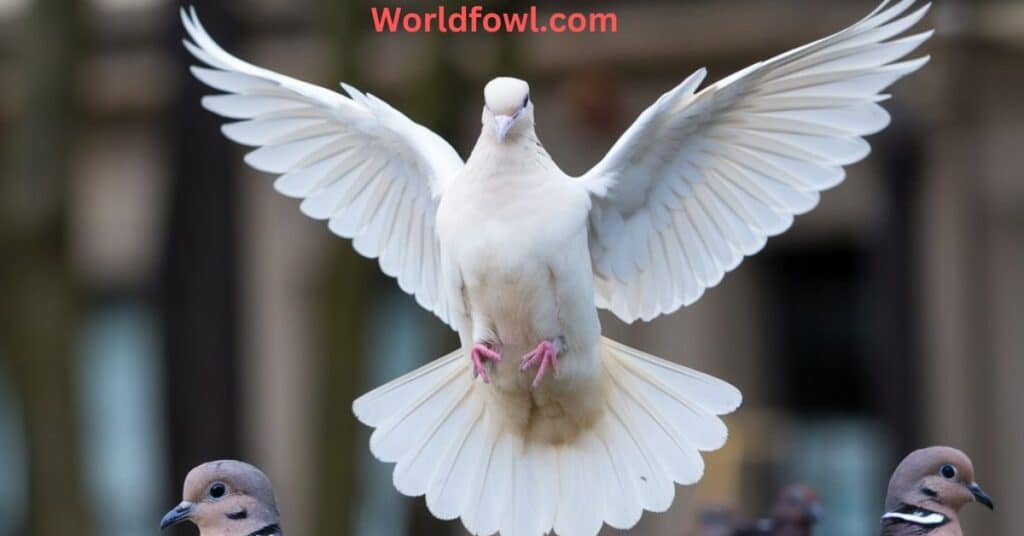
Misidentification can lead to misconceptions about mourning dove populations. Here are some common dove species that might be confused with mourning doves:
- White-winged Dove: Similar size, but with distinctive white wing patches
- Rock Pigeon: Larger, with more varied coloration
- Inca Dove: Smaller, with scaly-looking feathers
- Common Ground Dove: Much smaller, with a pinkish hue
Human-Related Factors
Our actions and lifestyles can have profound effects on wildlife, including mourning doves.
Noise Pollution: Drowning Out Nature’s Symphony
Urban and suburban areas are getting louder, which can impact bird behavior:
- Masking effect: Human-generated noise can drown out bird calls
- Behavioral changes: Some birds may alter their calling times or frequencies to be heard
- Stress responses: Chronic noise can lead to increased stress in birds, affecting their overall health and reproduction
Window Collisions and Urban Hazards
Buildings pose a significant threat to birds, including mourning doves:
- Up to 1 billion birds die annually from window collisions in the U.S. alone
- Reflective surfaces confuse birds, leading to fatal impacts
- Light pollution can disorient migrating birds, increasing collision risks
Pesticide Use and Its Impact on Dove Populations
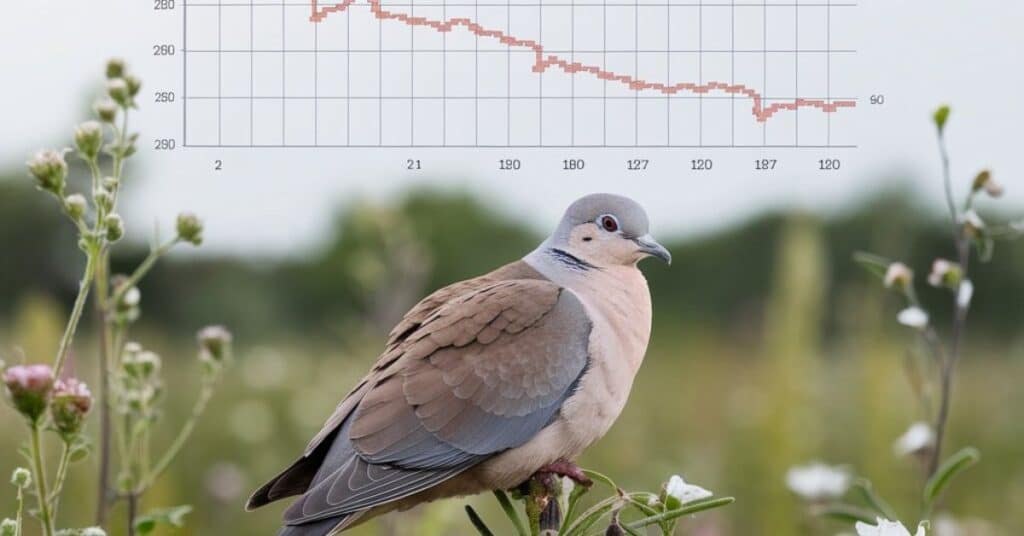
While mourning doves are primarily seed-eaters, pesticides can still affect them:
- Direct poisoning: Doves may ingest pesticide-coated seeds
- Reduced food supply: Pesticides can decrease insect populations, which young doves rely on
- Bioaccumulation: Toxins can build up in doves’ bodies over time, affecting their health and reproduction
Natural Predators and Threats
Mourning doves face various natural threats that can impact their populations.
Increased Raptor Populations: A Double-Edged Sword for Biodiversity
The recovery of many raptor species is a conservation success story, but it can affect prey species like mourning doves:
- Cooper’s hawks and sharp-shinned hawks are common predators of mourning doves
- Increased predation pressure can lead to behavioral changes in doves, including reduced vocalization
Domestic Cats: Silent Hunters in Our Backyards
Outdoor cats pose a significant threat to bird populations:
- Cats kill an estimated 2.4 billion birds annually in the U.S.
- Even well-fed cats hunt instinctively
- Bells on collars are not effective deterrents
Disease Outbreaks Affecting Dove Populations
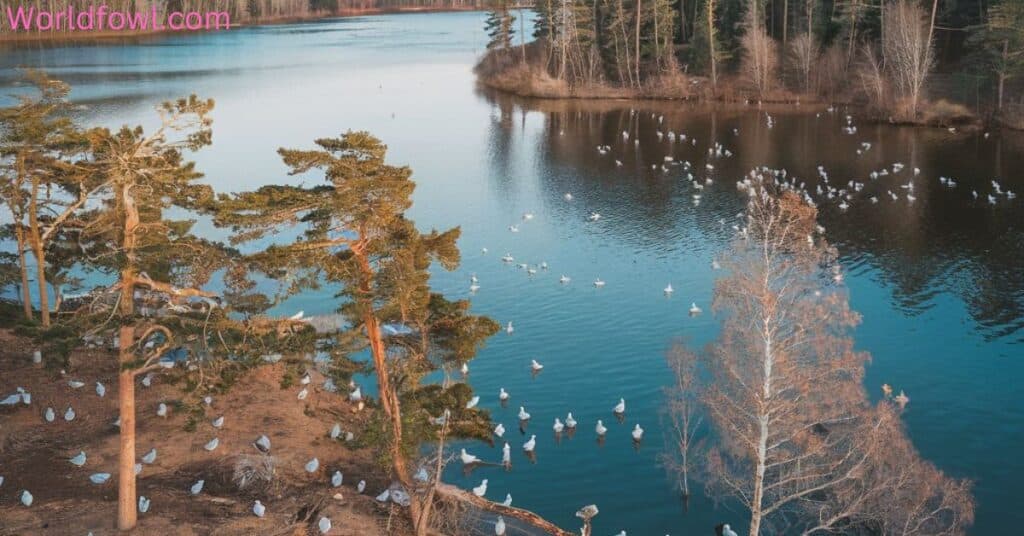
Like all wildlife, mourning doves are susceptible to various diseases:
- Trichomoniasis: A parasitic disease that can cause large-scale die-offs
- West Nile Virus: While less common in doves, it can still affect them
- Avian Pox: Causes lesions and can be fatal in severe cases
Conservation Efforts and Success Stories
Despite challenges, many initiatives are working to protect mourning doves and their habitats.
Local and National Initiatives to Protect Mourning Doves
- Migratory Bird Treaty Act: Provides legal protection for mourning doves and other migratory birds
- Habitat conservation programs: Organizations like Ducks Unlimited work to preserve wetlands and grasslands
- Urban green space initiatives: Cities are increasingly incorporating bird-friendly designs into urban planning
Citizen Science Projects Tracking Dove Populations
Everyday bird enthusiasts play a crucial role in monitoring mourning dove populations:
- Christmas Bird Count: Annual census of birds in the Western Hemisphere
- Project FeederWatch: Winter-long survey of birds that visit backyard feeders
- eBird: Global database of bird observations providing real-time data on bird distribution and abundance
Urban Planning with Wildlife in Mind
Progressive cities are adopting bird-friendly design practices:
- Lights Out programs: Encourage buildings to turn off lights during migration seasons
- Bird-safe glass: Using patterned or treated glass to reduce collisions
- Green roofs and walls: Creating urban habitats for birds and other wildlife
How to Attract Mourning Doves to Your Yard
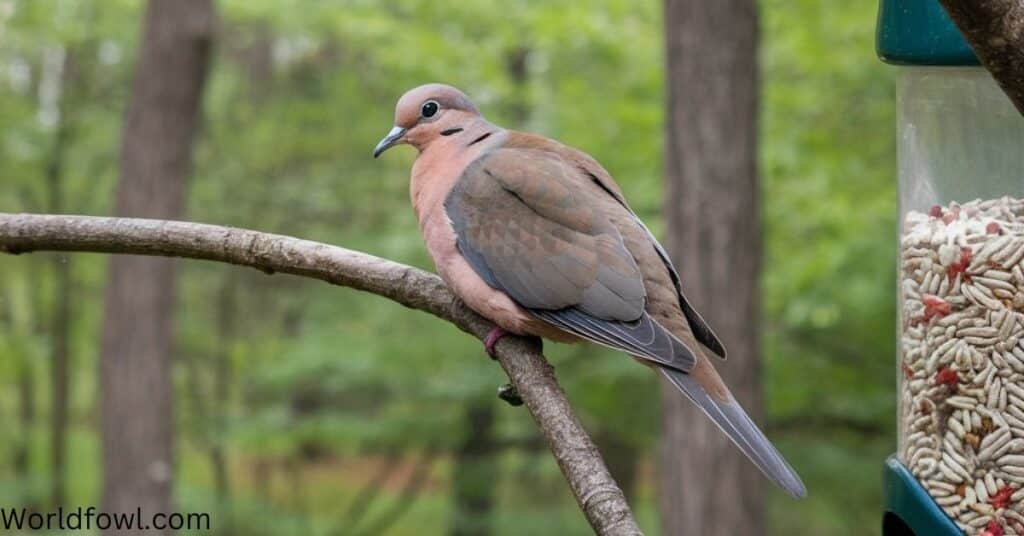
If you’re missing the soothing sounds of mourning doves, here are some ways to make your yard more inviting:
Creating a Dove-Friendly Habitat
- Plant native species: Sunflowers, millet, and other seed-bearing plants
- Provide nesting platforms: Simple flat surfaces 8-12 feet off the ground
- Offer roosting perches: Horizontal branches or wires for resting
- Maintain a brush pile: For shelter and nesting material
Proper Feeding Practices: Do’s and Don’ts
Do:
- Use platform feeders or scatter seeds on the ground
- Offer a mix of millet, cracked corn, and sunflower seeds
- Keep feeding areas clean to prevent disease spread
Don’t:
- Use tube feeders (doves prefer open feeding areas)
- Offer bread or other human foods
- Overload feeders (doves prefer to forage naturally)
Water Sources: More Than Just Birdbaths
Mourning doves need water for drinking and bathing:
- Install a shallow birdbath with gently sloping sides
- Consider a dripping water feature for added attraction
- Keep water sources clean and fresh
The Importance of Mourning Doves in Ecosystems
Mourning doves play several crucial roles in their habitats:
Their Role in Seed Dispersal
As prolific seed-eaters, mourning doves help disperse seeds across landscapes:
- Can consume up to 20% of their body weight in seeds daily
- Seeds pass through their digestive system quickly, aiding in dispersal
- Help maintain plant diversity in ecosystems
Doves as Prey Species: Supporting Predator Populations
Mourning doves are an important food source for various predators:
- Raptors (hawks, falcons)
- Mammals (foxes, coyotes)
- Reptiles (snakes)
Their abundance helps support healthy predator populations, maintaining ecological balance.
Indicators of Environmental Health
The presence or absence of mourning doves can provide insights into ecosystem health:
- Sensitive to habitat changes
- Affected by pesticide use and pollution
- Population fluctuations can signal broader environmental issues
Listening Techniques: Tuning into Nature
To increase your chances of hearing mourning doves, try these techniques:
Best Times and Seasons to Hear Mourning Doves
- Early morning: Just before and after sunrise
- Late afternoon: As birds settle in for the evening
- Spring and early summer: Peak breeding season
Distinguishing Mourning Dove Calls from Other Birds
Mourning dove calls are distinctive but can be confused with other species:
- Mourning Dove: Soft, drawn-out “coo-OO-oo” often repeated
- Eurasian Collared-Dove: Three-part “kuk-kooooo-kuk” with a harsher quality
- White-winged Dove: “Who-cooks-for-you” rhythm
Using Technology to Identify and Record Bird Calls
Several apps and tools can help you identify and record bird calls:
- Merlin Bird ID: Free app with sound identification feature
- eBird: Platform for recording and sharing bird observations
- Song Sleuth: App that analyzes and identifies bird songs in real-time
What You Can Do to Help
Everyone can contribute to mourning dove conservation:
Participating in Local Bird Counts and Surveys
- Join annual bird counts in your area
- Contribute observations to citizen science projects
- Volunteer with local wildlife organizations
Advocating for Bird-Friendly Policies in Your Community
- Support green space initiatives in urban planning
- Encourage adoption of bird-safe building practices
- Promote responsible pesticide use
Educating Others About the Importance of Urban Wildlife
- Share your knowledge with friends and family
- Organize community nature walks or bird-watching events
- Use social media to spread awareness about local wildlife
Conclusion: The Future of Mourning Doves
While you may be hearing fewer mourning doves in some areas, their overall population remains stable. However, continued conservation efforts are crucial to ensure their future:
- Current population trends: Relatively stable with some regional fluctuations
- Projections: Generally positive, but dependent on habitat preservation and climate change mitigation
- Individual impact: Your actions can make a difference in supporting local dove populations
By creating dove-friendly spaces, participating in conservation efforts, and staying informed, you can help ensure that the soothing coo of mourning doves continues to be a part of our natural soundscape for generations to come.
Remember, the apparent absence of mourning doves doesn’t necessarily mean they’re gone. By understanding their behavior, addressing environmental challenges, and taking positive action, we can create a world where these gentle birds thrive alongside us. Listen closely – you might just hear the soft, comforting call of a mourning dove, reminding us of the enduring beauty of nature in our midst.

Henry James is a seasoned blogger and a passionate storyteller on “World Fowl.” With years of experience crafting engaging content, he brings a unique blend of expertise and creativity to his writing. Henry specializes in exploring diverse topics with depth and clarity, captivating readers worldwide.

